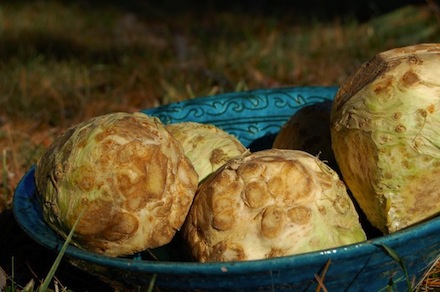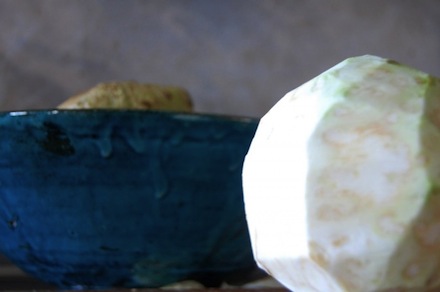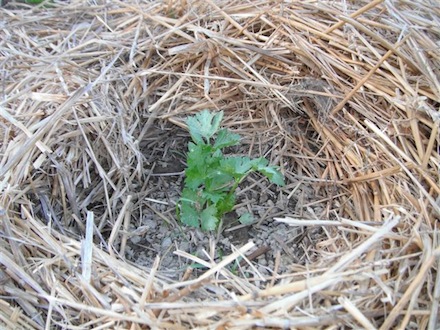
AgriCulture bloggers Peter Davies and Mark Scherzer are the owners of Turkana Farms in Germantown, NY. This week Peter writes. On the rare occasions I have found celeriac (also known as celery root or knob celery) in food stores, the cashier – looking down at what is a very large, ugly, knobby, gnarled root vegetable – invariably has asked, with a hint of disapproval, “What is that?” Despite its popularity in European, Middle Eastern, and North African cuisine, celeriac has, for reasons yet to be explained, not made much headway in American cookery. Those who do know it refer to it as the “frog prince” or “ugly duckling” of winter vegetables, but simultaneously laud it as a “royal vegetable.” To quote Jack Staub in a report he did for NPR: “…celeriac is so delicious, wonderfully hearty, and eminently storable…” The degree to which, nevertheless, celeriac remains unknown here is attested to by the scant information about it found in Wikipedia, which often goes on for pages and pages about other vegetables.

Like most people in this country I was unaware of its existence – that is, until I moved to Turkey in the early 1960s and was treated to celeriac slowly braised in olive oil, with some garlic, lemon juice, water, and sugar. Served at room temperature, this vegetable-in-oil dish is delicious. The flavor of celeriac is a subtle blend of celery and parsley, and its flesh is similar to that of a turnip or parsnip. Celeriac can serve as an excellent substitute for potatoes when it is boiled and mashed, or julienned and french fried. One thing in its favor, besides its deliciousness, is that it contains virtually no starch and few calories. That it tastes like celery is not surprising since it descends from the same wild species, found in the Mediterranean basin and parts of Europe, that celery does. It is a cousin of anise, carrots, parsley, and parsnips. While it was first recorded as a food plant in France in the 17th century, celeriac actually has a much longer food history in the Mediterranean basin; it is mentioned in Homer’s Odyssey in 800 BC (the ancient Greeks called it selinon). There are records of its medicinal and religious uses in many civilizations, including those of Egypt, Greece, and Italy. It is still credited with improving the milk flow of nursing mothers and regulating periods. And it is believed to act as a diuretic and to aid in the removal of kidney stones. And, a real selling point to aging men, it is believed that the magnesium and potassium in it combine to help with erectile dysfunctions by dilating the arteries and improving blood flow.

The French have, of course, worked their culinary magic on celeriac with such dishes as celerie remoulade, Celery Root Gratin, and Celeriac Roasted in Red Wine, as found in Amanda Hesser’s The Cook and the Gardener. But my favorite recipe is still Turkey’s celeriac braised in olive oil.* The road to these wonderful recipes, unfortunately, is through (as I have already pointed out) a rather ugly carapace — one that requires some dexterity to get through to the inner flesh. I have found that parboiling the whole unpeeled root for 5 to 10 minutes and then going at it with a paring knife yields good results. In the case of celeriac, as you will find after considerable scraping, is that beauty is indeed skin deep—that is, in the case of celeriac, beneath its warty-looking skin. We are, unfortunately, nowhere near being able to harvest our celeriac since it requires a long growing season of about 112 days from seeding. We are barely around 30 days into the process. It is on my mind right now only because we recently moved the seedlings out into the garden from the greenhouse.

A painful memory still is the difficulty we had with our celeriac last season when, after planting it three times – once in the greenhouse, twice in a garden plot – we ended up with all of three celeriac bulbs. Getting celeriac to germinate is usually a slow, and not always successful, process. But the real source of the problem was that some critter in the garden, probably a ground hog, developed a taste for it. Our seedlings seemed to vanish as quickly as they sprouted. This abysmal harvest was much in contrast to the bounty of the previous year, when we were able to store a good number of celeriac roots in the cool of our basement pantry for winter enjoyment. Mercifully, in the past few weeks our critter catcher has managed to trap seven ground hogs for us, and we are, therefore, hoping that this time it is we who get to enjoy the celeriac. But then, the other day, I was surprised and dismayed to see a young, glossy ground hog brazenly squatting in our garden. I am crossing my fingers that he is as oblivious to the wonderful taste of celeriac as the general American public is. But stay tuned. — Peter Davies*PETER'S VERSION OF TURKISH CELERIAC RECIPE 1) The best way to remove the knobby skin without losing too much of the root is to parboil it five to ten minutes. Then scrape off the softened skin and nodules. 2) Then you can either chop into small cubes or, if you prefer, julienne it. If you are using two of our standard celeriac roots then put a half cup of olive oil into a heavy bottomed skillet. When it is hot put the celeriac into the olive oil and stir it coating all of it with the oil. 3) Let it braise a bit on medium heat, for a half hour or so, stirring periodically. 4) Meanwhile bring a sauce pan of water to a boil. Squeeze the juice of a lemon. When the celeriac root begins to soften and has gotten a little color, pour the lemon juice over it and turn up the heat high. As it bubbles, add enough of the boiling water to just barely cover the celeriac. Add 1 or 2 tablespoons of sugar (depending on how sweet you like things). Salt and pepper the celeriac. 5) Turn the heat down very low and let the celeriac simmer for 1 1/2 to 2 hours, until the celeriac is soft and the liquid that’s left has a syrupy consistency. Turn it off and let it stand. It’s best served at room temperature, garnished with chopped dill and yogurt. ALTERNATIVES Cook it as you would mashed potatoes. After removing the skin as described above, chop the root into chunks and boil it in salted water. When soft add butter and milk, and mash. Or you can cook the celeriac as just described but with the addition of potatoes, carrots, and onions. Then mash after adding butter and milk. Thanks to RI's recipe blogger, cookbook author Alana Chernila, for the top two photos of celeriac.









